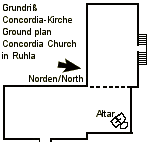Beginning
The Angle Church St. Concordia (built in the years 1660 – 1662)
Building History
“O LORD, I love the habitation of thy house, and the place where thy glory dwells”
(Psalms 26, 8)
After the celebration preparations began on March 23rd, 1660.
A street had to be constructed to get to the building site. A quarry had to be opened to make bricks from Ruhla Crystalline and a lime kiln was built to burn the Kittelsthal limestone Twenty socage workers dug up the earth where the foundation walls would be.
Few days later the actual building process was begun.
Twenty-five workers where employed at the site, working 14 hours daily, from 4am to 6pm. The workers coming from outside of town where accommodated in the houses of "Kickstein", the area further down the mountain.
The process of construction was not disturbed and went according to plan. It took one and a half years to build the church - without the steeple - and cost 4174 florins which had to be paid by the congregation without financial aid from outside. The building itself was finished in May 1661, another 4 months were used to create the interior.
Finally a separate house with the church bells was erected and the organ was built in.
On September 25th, 1661 the church was officially opened with a celebration attended by the duke, his four sons, the members of court, the Generalsuperintendent, the Superintendent and the Pastors from the surrounding towns.
The efforts, sacrifices and payments made by the 900 members of the congregation have to be appreciated.
The new church was called "St. Concordia" which is Latin for harmony, because it had been built "to settle the argument between the congregations". Thus St Concordia was meant to be "a temple of harmony, a place and a fountain of peace".
Her first Pastor was Gabriel Treiber who was 31 years old at the time and had been a collaborator at church in Weimar.
In the last weeks of 1661 and the beginning of 1662 the steeple was erected and in October 1662 the steeple top was completed.
Simultaneously, the parish office and the school house (which today is an extension to the old town hall) were built.
Note: Thanks to Helene Pawlitzki for doing the english translation!
Förderer unseres DKW - Projektes
Supporters of our socio - cultural project
Merci à nos donateurs
Grazie ai nostri donatori
Bedankt naar onze sponsors
Agradecemos a nuestros patrocinadores















